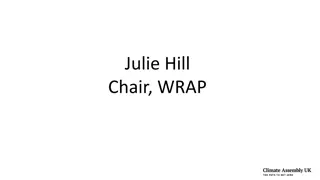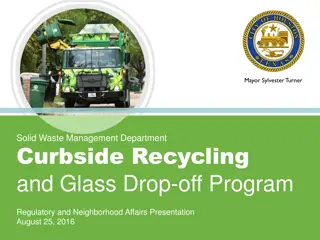Insights into Polymer Recycling: An Overview by Tom Pecorini
Explore the world of polymer recycling from an insider's perspective with Tom Pecorini. Discover the definition of recycling, post-consumer recycling challenges, and other types of recycling methods. Gain valuable insights into the recycling process and the importance of material collection and economic incentives.
Download Presentation

Please find below an Image/Link to download the presentation.
The content on the website is provided AS IS for your information and personal use only. It may not be sold, licensed, or shared on other websites without obtaining consent from the author. Download presentation by click this link. If you encounter any issues during the download, it is possible that the publisher has removed the file from their server.
E N D
Presentation Transcript
Polymer Recycling An Insider s Perspective Tom Pecorini December 16, 2014
Tom Pecorini Fellow in Polymers Technology Division PhD from Lehigh University Started at Eastman in 1992 Involved in many plastics development projects for SP Eastman s representative to the APR Chairman of the ASTM Section D20.95 on the RICs
Recycling Overview Definition of Recycling Types of Recycling Post Consumer - From Home to Bale Plastics - From Bale to Pellet Plastic Recycling Standards Resin Identification Codes
Definition of Recycling All materials are potentially recyclable, but not all materials are recycled Recycling involves BOTH collecting a material, AND having an economic incentive to convert it into a product Many factors limit both collection and economic incentive Recycling is a fight against entropy!! Apathy Dispersion Separation
Post Consumer Recycling Uses the residential waste stream as a source of material Must have >300lbs of common articles to make recycling worthwhile Paper/cardboard are the moneymakers Al, Fe, glass, PET and HDPE containers are break even There is no economic incentive to recycle anything else Deposit laws provide incentive Don t assume every composition within a given resin can be recycled together
Other Types of Recycling Post industrial Articles that have a controlled distribution system are also recycled, even at lower volumes Examples include computers and bulk water bottles Energy recovery Plastics have high energy content Energy recovery would dramatically reduce the amount of plastics diverted from the landfill Europe practices energy recovery, US does not
Post Consumer - From Home to Bale Source separation Residents place different articles in different bins Requires more effort by residents Original form of domestic recycling, but becoming less common Single stream Residents place all recyclables in a common bin and MRFs separate articles Greatly improves recycling rates due to simplicity Dirty MRF Both waste and recyclables are collected together MRFs sort everything
Single Stream MRFs These videos show how a single stream Material Recovery Facility (MRF) operates https://www.youtube.com/watch?v=_GP3JuiX5BY https://www.youtube.com/watch?v=osDD1TCBOJg https://www.youtube.com/watch?v=BjzyvzLSzNA
Plastics - From Bale to Pellet 96% of all post consumer plastics recycled in NA are bottles made from PET and HDPE Emerging interest in PET thermoforms and PP moldings MRFs bale the bottles Reclaimers convert the bales into pellets Converters turn the pellets into products Roughly 350 MRFs and 40 Reclaimers in US
US HDPE Recycling (2013) End-Use Total available MM lbs 3,300 % of available n/a % of bottles sold 100% Total recycled 1,100 100% 33% Non-Food Bottles Pipe Molded Parts Film & Sheet Net Export 390 290 290 50 80 35% 26% 26% 5% 8% 12% 9% 9% 1% 2%
US PET Recycling (2013) End-Use Total available MM lbs 5,700 % of available n/a % of bottles sold 100% Total recycled 1,800 100% 31% Fiber Bottles Sheet & Film Strapping Net Export 560 480 310 150 300 31% 27% 17% 8% 17% 10% 8% 5% 3% 5%
Contamination in Plastics Recycling Contamination reduces the value of a recycled product Sources of contamination Food products Look-alike bottles Labels, handles, etc. The tolerance for contamination depends on the end-use Most plastics are down-cycled, instead of re-cycled It is extremely difficult to get the quality of PET PCR good enough to go back into PET bottles Food contact, clear, pressurized, high barrier, etc
HDPE Process Reclaimer MRF Grind Flake Wash Sink/Float Color Sort Pelletize Converters
PET Process Reclaimer Full Bottle Wash Grind MRF Separate Color Metal PVC Flake Wash Sink/Float Pelletize Converters
Plastics Recycling Standards Many organizations post documents and standards to help people understand the impact of their designs and innovations on the recycling stream as well as to show the benefits of recycling plastics Association of Post Consumer Plastics Recycling (APR) National Assn. for PET Container Resources (NAPCOR) American Chemical Council (ACC) Society of the Plastics Industry (SPI) Sustainable Packaging Coalition (SPC)
Resin Identification Codes In 1988, the only plastic articles being collected and recycled in the US were PET soda bottles and HDPE milk jugs It was assumed that other resins would be recycled if only they could be properly identified in the waste stream Thus, SPI developed the RIC system to identify the six most common packaging resins found in the municipal waste stream The RICs are being updated by ASTM, at SPI s request ASTM D7611 is the Standard
Resin Identification Code Facts RICs are NOT recycling codes NOT all articles with an RIC are collected for recycling NOT all articles with a given RIC are recycled - many compositions within a given RIC are not compatible with each other The RICs were NOT originally intended for use by the general public - the chasing arrows on an RIC were merely intended to help sorters on a sorting line identify the resin 7 does NOT mean contains BPA or other dangerous chemicals
Changes to D7611 Convert the Chasing Arrows into Triangles Add sub-codes to improve identification 1-6 7 Become adopted by the states























